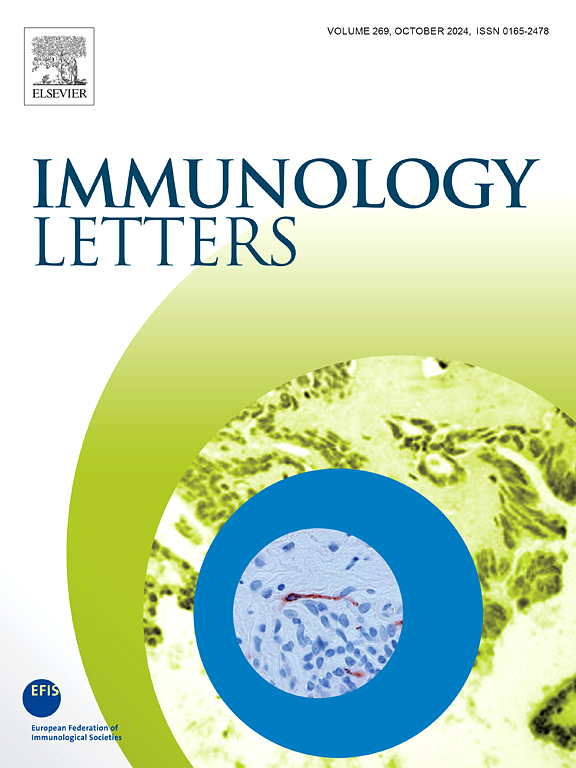Systemic and cerebrospinal fluid immune mediators coordinate a dichotomic microenvironment in parturients with acute or convalescent phases of COVID-19
IF 2.8
4区 医学
Q3 IMMUNOLOGY
引用次数: 0
Abstract
The present study intended to characterize the profile of soluble immune mediators in serum samples and in the cerebrospinal fluid (CSF) microenvironment from parturients with acute and convalescent COVID-19 as compared to healthy controls (HC), during the circulation of B.1.1.28 and B.1.1.33 SARS-CoV-2 strains, which were identified during the initial spread of COVID-19 in Brazil. Data demonstrated increased levels of immune mediators in serum at acute infection with a clear waning during convalescent COVID-19. Conversely, a progressive increase of immune mediators was observed in CSF from acute infection towards convalescent COVID-19. Immune mediator signatures and integrative correlation circuits further confirmed these findings and supported the existence of dichotomic microenvironments in the serum and CSF compartments. While a waning of correlations involving pro-inflammatory cytokines with increased connectivity of regulatory cytokines was observed in serum samples from acute towards convalescent COVID-19, an increasing frequency of correlations mediated by pro-inflammatory cytokines with decreased connectivity of regulatory cytokine was the hallmark of CSF. Correlations analysis identified a set of molecules associated with the dichotomic crosstalk between serum and CSF compartments, including chemokines (CXCL8, CCL5, CXCL10) and regulatory cytokines (IL-4 and IL-9). These immune biomarkers may represent potential targets for therapeutic strategies in parturients with COVID-19. Together, these findings demonstrated the existence of a divergent landscape of soluble immune mediators in serum and CSF, emphasizing the relevance of understanding the systemic and compartmentalized immune response elicited by SARS-CoV-2 infection during pregnancy.
在COVID-19急性期或恢复期的产妇中,全身和脑脊液免疫介质协调了二元微环境。
本研究旨在表征在巴西COVID-19最初传播期间鉴定出的B.1.1.28和B.1.1.33 SARS-CoV-2菌株循环期间,急性和恢复期COVID-19患儿血清样本和脑脊液(CSF)微环境中可溶性免疫介质的特征,并与健康对照(HC)进行比较。数据显示,急性感染时血清中免疫介质水平升高,在COVID-19恢复期明显下降。相反,从COVID-19急性感染到恢复期,脑脊液中免疫介质的含量逐渐增加。免疫介质特征和综合相关回路进一步证实了这些发现,并支持血清和脑脊液室中存在二分微环境。虽然在COVID-19急性期至恢复期的血清样本中观察到促炎细胞因子与调节细胞因子连通性增加的相关性减弱,但促炎细胞因子介导的相关性增加频率与调节细胞因子连通性降低是CSF的标志。相关性分析确定了一组与血清和CSF室间二元串音相关的分子,包括趋化因子(CXCL8, CCL5, CXCL10)和调节细胞因子(IL-4和IL-9)。这些免疫生物标志物可能代表COVID-19患儿治疗策略的潜在靶点。总之,这些发现表明血清和脑脊液中存在可溶性免疫介质的不同格局,强调了理解妊娠期间SARS-CoV-2感染引发的系统性和区分性免疫反应的相关性。
本文章由计算机程序翻译,如有差异,请以英文原文为准。
求助全文
约1分钟内获得全文
求助全文
来源期刊

Immunology letters
医学-免疫学
CiteScore
7.60
自引率
0.00%
发文量
86
审稿时长
44 days
期刊介绍:
Immunology Letters provides a vehicle for the speedy publication of experimental papers, (mini)Reviews and Letters to the Editor addressing all aspects of molecular and cellular immunology. The essential criteria for publication will be clarity, experimental soundness and novelty. Results contradictory to current accepted thinking or ideas divergent from actual dogmas will be considered for publication provided that they are based on solid experimental findings.
Preference will be given to papers of immediate importance to other investigators, either by their experimental data, new ideas or new methodology. Scientific correspondence to the Editor-in-Chief related to the published papers may also be accepted provided that they are short and scientifically relevant to the papers mentioned, in order to provide a continuing forum for discussion.
 求助内容:
求助内容: 应助结果提醒方式:
应助结果提醒方式:


